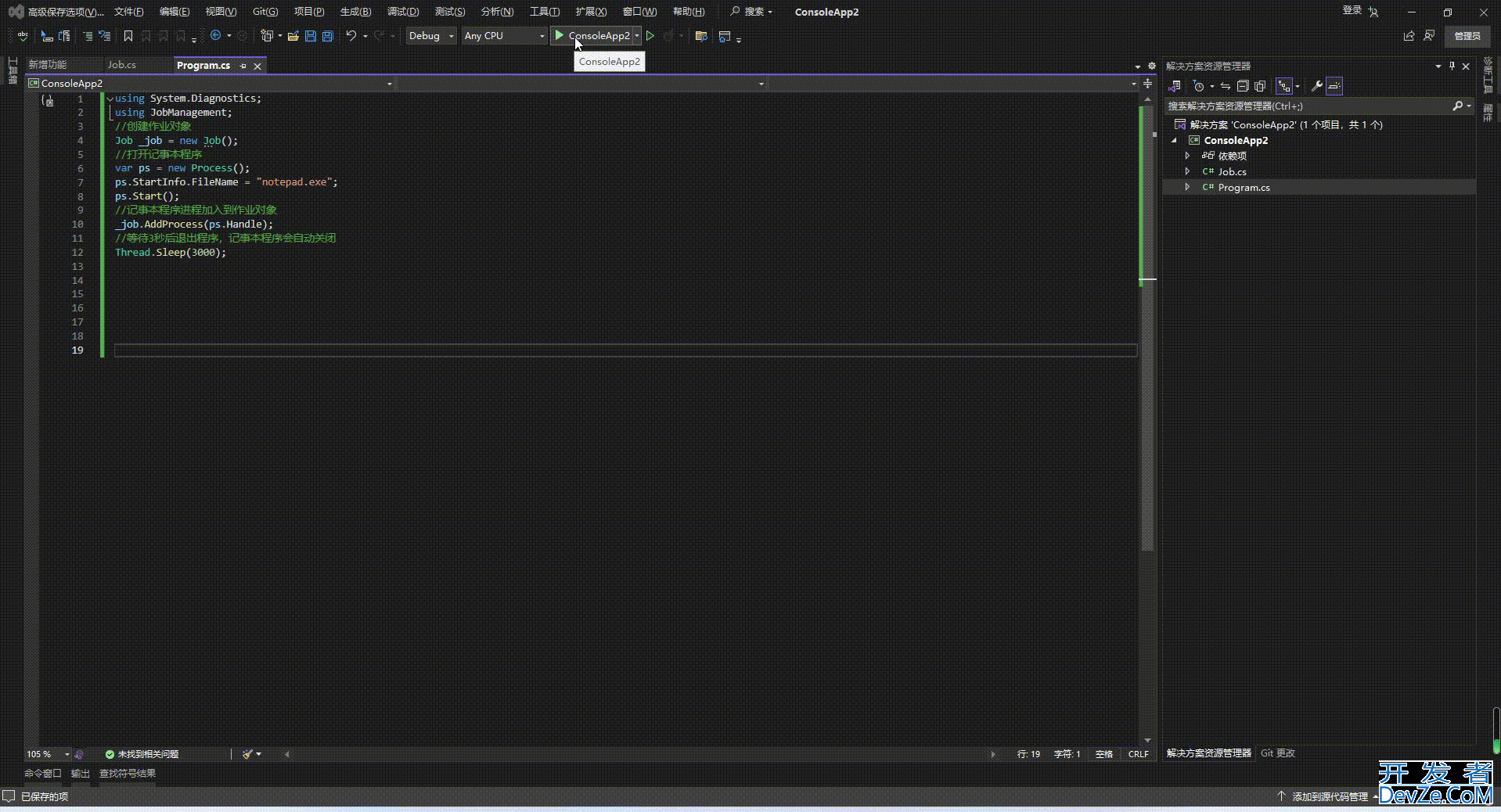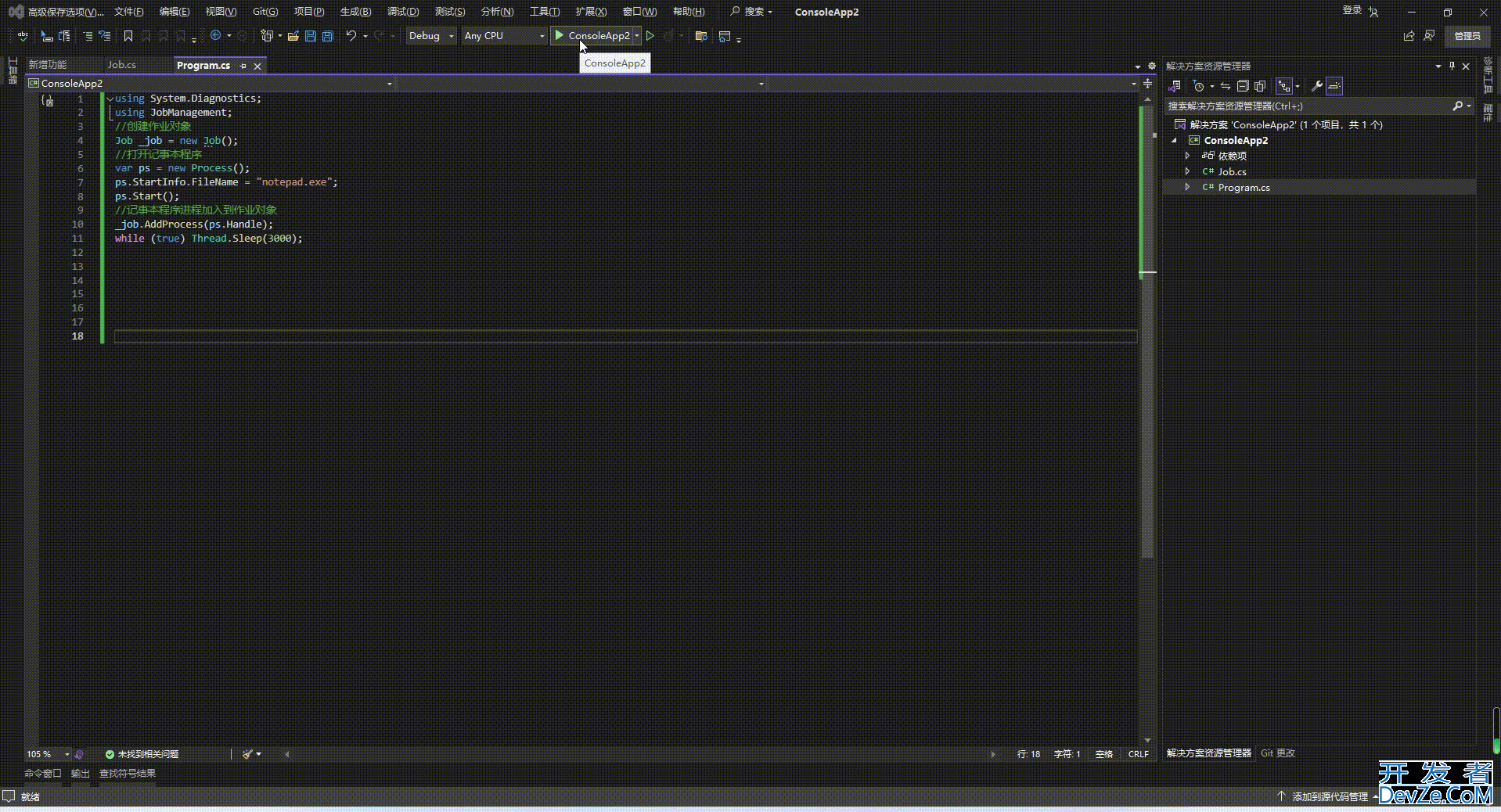C#如何实现子进程跟随主进程关闭
目录
- 前言
- 一、如何实现
- 1、创建作业对象
- 2、子进程加入作业对象
- 3、销毁作业对象
- 二、完整代码
- 三、使用示例
- .net8.0
- 2、异常退出自动结束子进程
- 总结
前言
多进程开发经常会遇到主进程关闭,子进程需要跟随主进程一同关闭。比如调ffmpeg命令行实现的录屏程序,录屏程序关闭,ffmpeg进程也需要退出。我们通常在程序关闭时调用Process.Kill()杀掉fmpeg进程即可。但是如果是强制或异常关闭录屏程序,ffmpeg将会变成僵尸进程残留在系统中。本文将提供一种解决此类问题的方法。
一、如何实现
1、创建作业对象
(1)、创建对象
handle = CreateJobObject(IntPtr.Zero, null);
(2)、设置销毁作业时,关闭拥有的进程
var info = new JOBOBJECT_BASIC_LIMIT_INFORMATION
{
LimitFlags = 0x2000
};
var extendedInfo = new JOBOBJECT_EXTENDED_LIMIT_INFORMATION
{
php BasicLimitInformation = info
};
int length = Marshal.SizeOf(typeof(JOBOBJECT_EXTENDED_LIMIT_INFORMATION));
IntPtr extendedInfoPtr = Marshal.AllocHGlobal(length);
Marshal.StructureToPtr(extendedInfo, extendedInfoPtr, false);
if (!SetInformationJoandroidbObject(handle, JobObjectInfoType.ExtendedLimitInformation, extendedInfoPtr, (uint)length))
throw new Exception(string.Format("Unable to set information. Error: {0}", Marshal.GetLastWin32Error()));
2、子进程加入作业对象
AssignProcessToJobObject(handle, processHandle);
3、销毁作业对象
(1)、手动销毁
CloseHandle(handle);
(2)、所在进程结束自动销毁
二、完整代码
using System.Diagnostics;
using System.Runtime.InteropServices;
namespace JobManagement
{
#region Helper classes
/// <summary>
/// 作业对象,主要用于子进程管理。
/// 目前版本是只支持作业销毁拥有的子进程退出
/// 通常可以定义一个全局静态变量使用
/// </summary>
public class Job : IDisposable
{
[DllImport("kernel32.dll", CharSet = CharSet.Unicode)]
static extern IntPtr CreateJobObject(IntPtr a, string lpName);
[DllImport("kernel32.dll")]
static extern bool SetInformationJobObject(IntPtr hJob, JobObjectInfoType infoType, IntPtr lpJobObjectInfo, UInt32 cbJobObjectInfoLength);
[DllImport("kernel32.dll", SetLastError = true)]
static extern bool AssignProcessToJobObject(IntPtr job, IntPtr process);
[DllImport("kernel32.dll", SetLastError = true)]
[return: MarshalAs(UnmanagedType.Bool)]
static extern bool CloseHandle(IntPtr hObject);
private IntPtr handle;
private bool disposed;
public Job()
{
handle = CreateJobObject(IntPtr.Zero, null);
var info = new JOBOBJECT_BASIC_LIMIT_INFORMATION
{
LimitFlandroidags = 0x2000
};
var extendedInfo = new JOBOBJECT_EXTENDED_LIMIT_INFORMATION
{
BasicLimitInformation = info
};
int length = Marshal.SizeOf(typeof(JOBOBJECT_EXTENDED_LIMIT_INFORMATION));
IntPtr extendedInfoPtr = Marshal.AllocHGlobal(length);
Marshal.StructureTo编程客栈Ptr(extendedInfo, extendedInfoPtr, false);
if (!SetInformationJobObject(handle, JobObjectInfoType.ExtendedLimitInformation, extendedInfoPtr, (uint)length))
throw new Exception(string.Format("Unable to set information. Error: {0}", Marshal.GetLastWin32Error()));
}
/// <summary>
/// 进程加入到作业对象中
/// </summary>
/// <param name="processHandle">进程句柄</param>
/// <returns></returns>
public bool AddProcess(IntPtr processHandle)
{
return AssignProcessToJobObject(handle, processHandle);
}
/// <summary>
/// 进程加入到作业对象中
/// </summary>
/// <param name="processId">进程Id</param>
/// <returns></returns>
public bool AddProcess(int processId)
{
return AddProcess(Process.GetProcessById(processId).Handle);
}
/// <summary>
/// 销毁作业对象,手动调用则其拥有的所有进程都会退出
/// </summary>
public void Dispose()
{
Dispose(true);
GC.SuppressFinalize(this);
}
/// <summary>
/// 销毁作业对象,手动调用则其拥有的所有进程都会退出
/// </summary>
public void Close()
{
CloseHandle(handle);
handle = IntPtr.Zero;
}
private void Dispose(bool disposing)
{
if (disposed)
return;
if (disposing) { }
Close();
disposed = true;
}
}
[StructLayout(LayoutKind.Sequential)]
struct IO_COUNTERS
{
public UInt64 ReadOperationCount;
public UInt64 WriteOperationCount;
public UInt64 OtherOperationCount;
public UInt64 ReadTransferCount;
public UInt64 WriteTransferCount;
public UInt64 OtherTransferCount;
}
[StructLayout(LayoutKind.Sequential)]
struct JOBOBJECT_BASIC_LIMIT_INFORMATION
{
public Int64 PerProcessUserTimeLimit;
public Int64 PerJobUserTimeLimit;
public UInt32 LimitFlags;
public UIntPtr MinimumWorkingSetSize;
public UIntPtr MaximumWorkingSetSize;
public UInt32 ActiveProcessLimit;
public UIntPtr Affinity;
public UInt32 PriorityClass;
public UInt32 SchedulingClass;
}
[StructLayout(LayoutKind.Sequential)]
public struct SECURITY_ATTRIBUTES
{
public UInt32 nLength;
public IntPtr lpSecurityDescriptor;
public Int32 bInheritHandle;
}
[StructLayout(LayoutKind.Sequential)]
struct JOBOBJECT_EXTENDED_LIMIT_INFORMATION
编程客栈 {
public JOBOBJECT_BASIC_LIMIT_INFORMATION BasicLimitInformation;
public IO_COUNTERS IoInfo;
public UIntPtr ProcessMemoryLimit;
public UIntPtr JobMemoryLimit;
public UIntPtr PeakProcessMemoryUsed;
public UIntPtr PeakJobMemoryUsed;
}
public enum JobObjectInfoType
{
AssociateCompletionPortInformation = 7,
BasicLimitInformation = 2,
BasicUIRestrictions = 4,
EndOfJobTimeInformation = 6,
ExtendedLimitInformation = 9,
SecurityLimitInformation = 5,
GroupInformation = 11
}
#endregion
}
三、使用示例
1、正常退出自动结束子进程
.net8.0
using System.Diagnostics; using JobManagement; //创建作业对象 Job _job = new Job(); //打开记事本程序 var ps = new Process(); ps.StartInfo.FileName = "notepad.exe"; ps.Start(); //记事本程序进程加入到作业对象 _job.AddProcess(ps.Handle); //等待3秒后退出程序,记事本程序会自动关闭 Thread.Sleep(3000);
效果预览

2、异常退出自动结束子进程
.net8.0
using System.Diagnostics; using JobManagement; //创建作业对象 Job _job = new Job(); //打开记事本程序 var ps = new Process(); ps.StartInfo.FileName = "notepad.exe"; ps.Start(); //记事本程序进程加入到作业对象 _job.AddProcess(ps.Handle); while(true)Thread.Sleep(3000);
效果预览

总结
本文讲述的内容是Windows多进程开发中比较重要的技术,因为大部分场景主进程退出后子进程应该跟随退出,正常流程中通过代码可以在退出时关闭所有子进程,但是异常崩溃时则不行,会出现遗留子进程。而本文的方法就很好的解决的这个问题,而且也不需要编写任何关闭子进程的相关代码,方便且省心。
以上就是C#如何实现子进程跟随主进程关闭的详细内容,更多关于C#子进程跟随主进程关闭的资料请关注编程客栈(www.devze.com)其它相关文章!







 加载中,请稍侯......
加载中,请稍侯......
精彩评论